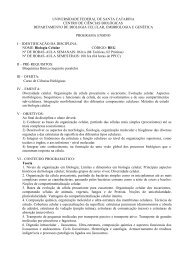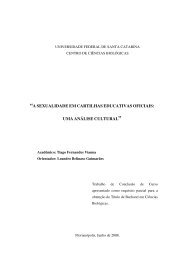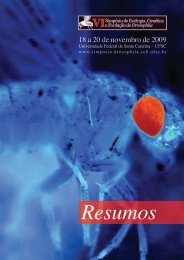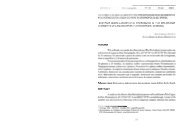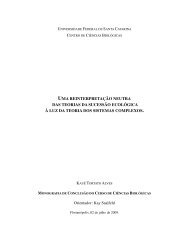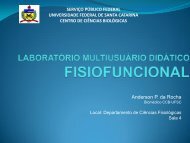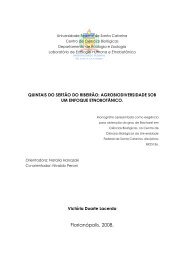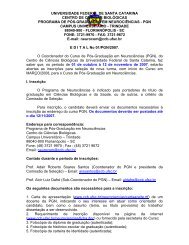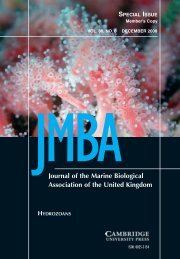1680 allen g. collins et al.Fig. 8. Phylogenetic hypothesis based on combined 16S, SSU, and LSU data (dataset 5). Phylogram <strong>of</strong> ML topology, <strong>with</strong> bootstrap indices under bothML and MP at each node. ‘ , ’ indicates a bootstrap index <strong>of</strong> less than 61; a single 100 or , was placed at nodes if indices under both criteria were 100or less than 61, respectively. For ML analyses, the assumed model <strong>of</strong> nucleotide evolution was GTR þ I þ G. Scale bar is equivalent to 0.1 substitutionsper site.Craspedacusta; the trachymedusan genera Geryonia and Lirope(Geryoniidae); the trachymedusan genera Haliscera, Halicreasand Botrynema (Halicreatidae); the trachymedusan generaRhopalonema and Pantachogon; the trachymedusan generaAmphogona, Aglaura and Aglantha; and, the narcomedusangenera Aegina, Solmundella and Solmissus.Figure 6 shows the strict consensus <strong>of</strong> 21 MP trees found insearches using the SSU dataset. With three exceptions, all <strong>of</strong>the relationships strongly supported by the mitochondrial16S analyses (Figure 5) receive method independent supportfrom the SSU data. The first exception is that there is nosupport for the splitting <strong>of</strong> <strong>Trachylina</strong> into two main clades.The second exception is that the ML bootstrap support forthe node linking Haliscera, Halicreas and Botrynema(Halicreatidae) is only 54. The third exception is that theclade linking Aegina citrea, Solmundella and Solmissus alsoincludes Tetraplatia volitans, which had an uncertain positionbased on the 16S data. Additional clades receiving support, asmeasured by both MP and ML bootstraps are: the limnomedusantaxa Aglauropsis (marine) and Maeotias (brackish)<strong>with</strong> the freshwater Craspedacusta and Limnocnida; the limnomedusangenus Olindias <strong>with</strong> Geryoniidae; and, the twotrachmedusan clades (Rhaopalonema þ Pantachogon andAmphogona þ Aglaura þ Aglantha).The strict consensus <strong>of</strong> 12 MP trees based on the LSUdata supports many <strong>of</strong> the relationships also indicated bythe 16S and SSU analyses (Figure 7). One <strong>of</strong> the two maintrachyline clades (non-geryoniid trachymedusans, narcomedusansand the actinulidan Halammohydra sp.) suggestedby 16S is also supported by LSU data. Two additional cladesthat receive high bootstrap support from LSU data underboth MP and ML criteria are: all sampled representatives <strong>of</strong>Rhopalonematidae plus Halammohydra sp.; and, all sampledrepresentatives <strong>of</strong> Narcomedusae.Finally, Figure 8 shows the ML topology using the combineddataset. Given the great amount <strong>of</strong> correspondencebetween the different single-marker analyses, it is not surprisingthat this combined analysis contains nearly all <strong>of</strong>the associations enumerated above. In total comparingacross all the single-marker analyses, there is only oneinstance <strong>of</strong> relationships receiving strong contradictorysupport. The SSU, LSU and combined data support an alliance<strong>of</strong> Aegina citrea, Solmundella, Solmissus andTetraplatia volitans, whereas the 16S analyses suggestedthat the first three taxa form a well-supported clade exclusive<strong>of</strong> Tetraplatia.D I S C U S S I O NScope <strong>of</strong> LimnomedusaeLimnomedusae has a somewhat complicated taxonomic historythat reflects uncertainty about the phylogenetic affinities <strong>of</strong> thegroups that constitute it, as well as confusion arising from thehistorical use <strong>of</strong> separate taxonomic systems by experts onhydromedusae and hydroids. The taxon was created in thelate 1930s (Kramp, 1938; Browne & Kramp, 1939) for species
phylogenetics <strong>of</strong> trachylina 1681<strong>of</strong> the families Moerisiidae, Olindiasidae (¼Olindiidae) andProboscidactylidae. The underlying concept <strong>of</strong> Limnomedusaewas that it should receive species <strong>with</strong> a biphasic lifecycle, whose medusae did not fit the Anthoathecata(¼Anthomedusae or Athecata) because they had eitherecto-endodermal statocysts or gonads along their radialcanals, and whose polyps did not fit the Leptothecata(¼Leptomedusae or Thecata) because they lacked a theca.Subsequently, Monobrachiidae, which also meets the criteriaabove, has been added to Limnomedusae (Naumov, 1960),as have the small and simple species <strong>of</strong> Armorhydridae andMicrohydrulidae, for lack <strong>of</strong> better alternatives (Bouillon,1985). More detailed analysis that included information onthe cnidome indicated that Moerisiidae is more likely toshare a recent common ancestry <strong>with</strong> members <strong>of</strong> theanthoathecate group Capitata (Rees, 1958; Petersen, 1990).Likewise, the absence <strong>of</strong> statocysts and the presence <strong>of</strong> desmonemesstrongly favour the hypothesis that Proboscidactylidaeis closely related to anthoathecate species classified as Filifera(Edwards, 1973; Schuchert, 1996). Recently, molecular datahave confirmed that Moerisidae and Proboscidactylidae donot belong in Limnomedusae (Collins et al., 2006a), therebylimiting its scope to Armorhydridae, Microhydrulidae,Monobrachidae and Olindiasidae. To a certain extent, ourresults (Figures 4–8) challenge this view <strong>of</strong> Limnomedusae,as further discussed below.Microhydrula limopsicola is a species <strong>of</strong>StauromedusaeMicrohydrula limopsicola (originally classified <strong>with</strong>inLimnomedusae) is an Antarctic species that possessesminute polyps found living on bivalve shells (Jarms &Tiemann, 1996; Figure 2C). The polyps are less than 0.5 mmin length and 0.35 mm in diameter and solitary, though theydo form aggregates. The morphology <strong>of</strong> the polyps is quitesimple as they lack tentacles and possess just a single type<strong>of</strong> nematocyst, microbasic euryteles. These polyps wereobserved to rest on a thin periderm and produce creeping,asexual frustules (Jarms & Tiemann, 1996). The polyps<strong>of</strong> Limnomedusae (where known) are tiny, <strong>of</strong>ten <strong>with</strong>outtentacles (e.g. Figure 2A), capable <strong>of</strong> producing frustules,and typically armoured <strong>with</strong> microbasic euryteles. This suite<strong>of</strong> features therefore suggests that M. limopsicola should bepart <strong>of</strong> Limnomedusae. Thus, it is quite surprising thatgenetic data taken from samples <strong>of</strong> M. limopsicola stronglyindicate that it is actually part <strong>of</strong> the non-hydrozoanStauromedusae (Figure 4).Concern that this result was a product <strong>of</strong> contaminationprompted a re-sampling <strong>of</strong> a culture <strong>of</strong> Microhydrula limopsicolamaintained in the Jarms laboratory. This yielded the samedata, indicating that M. limopsicola is a member <strong>of</strong>Stauromedusae. In fact, in an ongoing study <strong>of</strong>Stauromedusae, mt16S data (Collins et al., unpublisheddata) identify M. limopsicola as a member <strong>of</strong> the genusHaliclystus, <strong>with</strong> a very close relationship to the species<strong>of</strong> Haliclystus from southern Chile reported on by Zagal(2004).The most straightforward way to reconcile the interpretation<strong>of</strong> M. limopsicola as described by Jarms & Tiemann(1996) is that it likely represents a microscopic life cyclestage not previously known in Stauromedusae. This wouldexplain why no gonads were observed by Jarms & Tiemann(1996). Life cycles <strong>of</strong> stauromedusans (and indeed mostcnidarians) are not well known or documented. In particular,the juvenile stages <strong>of</strong> very few stauromedusan species areknown. The only case for which the actual habitat <strong>of</strong> juvenilestauropolyps is known is for two species <strong>of</strong> Stylocoronella,whose polyps live interstitially (Salvini-Plawen, 1987;Kikinger & Salvini-Plawen, 1995). Euryteles are widelydistributed across Medusozoa, including Stauromedusae,so this character is not difficult to reconcile. However,this would appear to be the first time that a periderm andfrustules have been recognized in any species <strong>of</strong>Stauromedusae. Both features are known from species<strong>with</strong>in Discomedusae (Scyphozoa) and Limnomedusae(<strong>Hydrozoa</strong>) suggesting that they have evolved independentlyat least two times.It is unclear if this result could be extended to other species<strong>of</strong> Microhydrulidae, the limnomedusan family to whichM. limopsicola was assigned. The family contains just threespecies in two genera, and no adults or sexual reproductionhave been reported from any <strong>of</strong> them. Microhydrula ponticais very similar in morphology to M. limopsicola and it maybe that this species too, known from the northern Atlantic,represents another species <strong>of</strong> Stauromedusae. Rhaptapagiscantacuzeni, the third representative <strong>of</strong> the family, is differentiatedfrom the other species by the possession <strong>of</strong> an unusualform <strong>of</strong> microbasic euryteles known as semiophores (Bouillon &Deroux, 1967). DNA sampling <strong>of</strong> these taxa should help toresolve phylogenetic affinities <strong>of</strong> these species.Freshwater limnomedusansWe present some <strong>new</strong> mt16S data for freshwater limnomedusans.These data further reinforce (albeit <strong>with</strong> low support) thehypothesis that freshwater limnomedusans had a single evolutionaryorigin (Figure 5, but note the robust support inFigure 8). Among our 16S samples is a representative <strong>of</strong>Craspedacusta ziguensis. As reviewed by Jankowski (2001),the validity <strong>of</strong> this species has been in doubt. However, ourmt16S data, which include representatives <strong>of</strong> two otherreadily accepted species <strong>of</strong> Craspedacusta, C. sowerbii andC. sinensis, indicate that C. ziguensis has comparable divergencesfrom these two species (P distances <strong>of</strong> 7.4% and6.1%, respectively) as they do from each other (8.8%). TheSSU and 16S data show Craspedacusta to have a close relationshipto the freshwater genus Limnocnida. The polyps <strong>of</strong> thetwo genera are nearly indistinguishable: they are diminutive(1 mm or less in length), form small colonies up to seven individuals,lack tentacles, possess papillae <strong>with</strong> eurytele nematocystsat their oral ends, and produce creeping frustules thatdevelop into additional polyps (Bouillon, 1957). The otherfreshwater species sampled here, Astohydra japonica, also producesfrustules, but the polyps are smaller (up to 0.3 mm inlength), solitary, and have 10 to 20 nematocyst-rich tentaclescomposed <strong>of</strong> single cells that may be homologous <strong>with</strong> thepapillae <strong>of</strong> Craspedacusta and Limnocnida polyps(Hashimoto, 1981). The polyps <strong>of</strong> Astrohydra japonica andthose <strong>of</strong> another freshwater genus, Calpasoma (not yetsampled for molecular data), are indistinguishable, and if itwere not for the presence <strong>of</strong> a poorly known medusa stagein the former (Hashimoto, 1985), the two would have to beconsidered conspecific.




